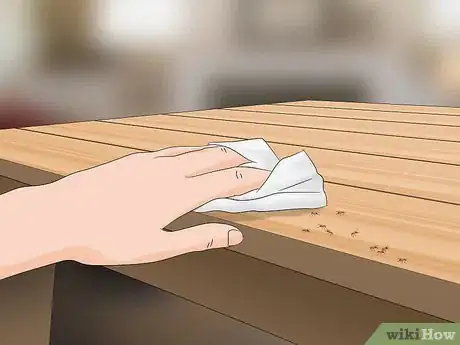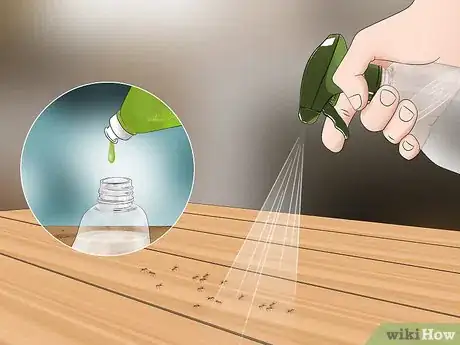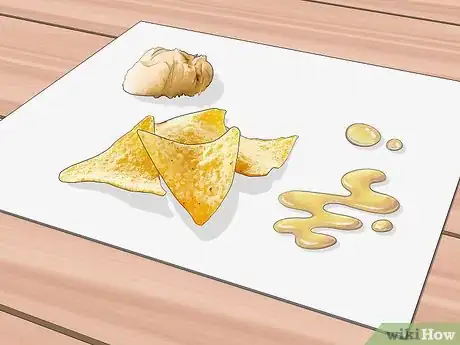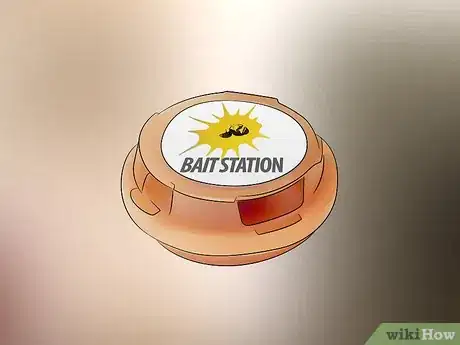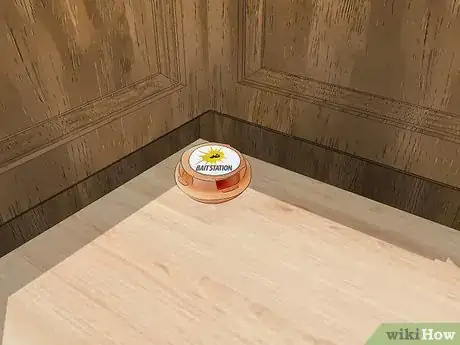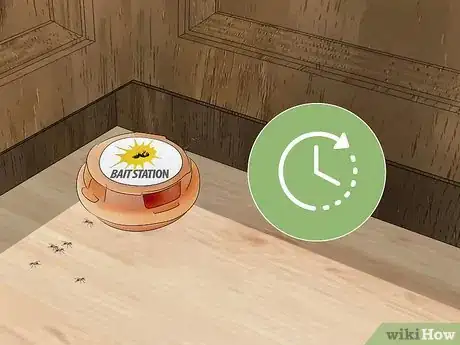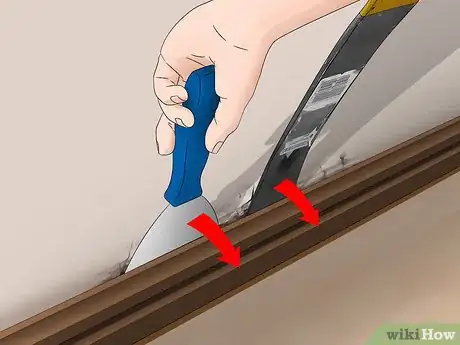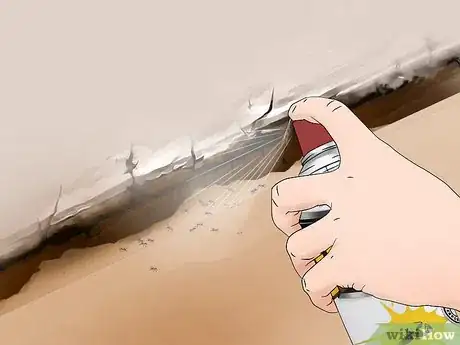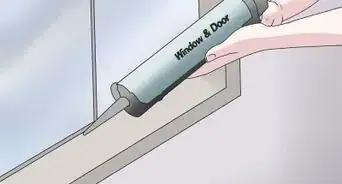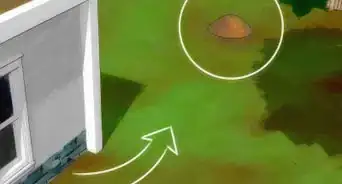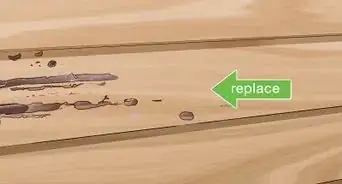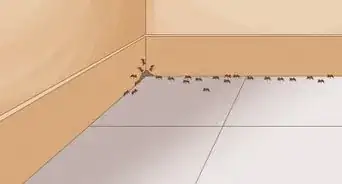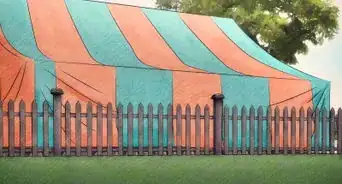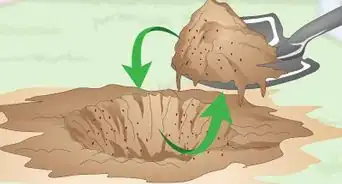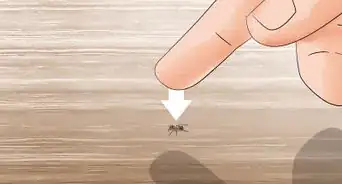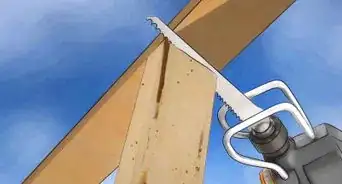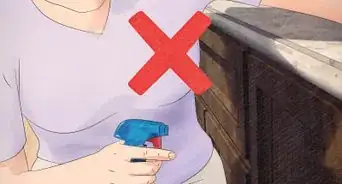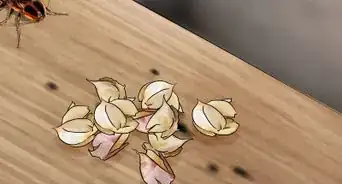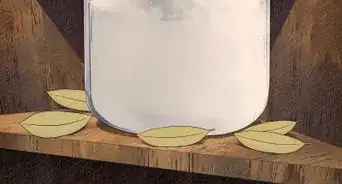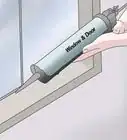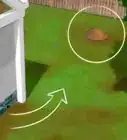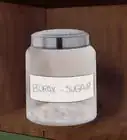This article was co-authored by Kevin Carrillo and by wikiHow staff writer, Christopher M. Osborne, PhD. Kevin Carrillo is a Pest Control Specialist and the Senior Project Manager for MMPC, a pest control service and certified Minority-owned Business Enterprise (MBE) based in the New York City area. MMPC is certified by the industry’s leading codes and practices, including the National Pest Management Association (NPMA), QualityPro, GreenPro, and The New York Pest Management Association (NYPMA). MMPC's work has been featured in CNN, NPR, and ABC News.
This article has been viewed 84,643 times.
Common house ants, which are less than 0.125 in (3.2 mm) long, are primarily a nuisance that you can squash or spray to kill. However, to get rid of the entire colony, use poisoned bait stations and let the worker ants destroy their own nest. If you have carpenter ants in your home—which are 0.25–0.5 in (6.4–12.7 mm) long and nest in damp or rotted wood—it’s important that you eliminate the colony right away. Dig into the damaged area, eradicate the nest with insecticide, and make repairs, or hire a pro to do the job.
Steps
Killing Individual Ants
-
1Smash individual ants with your shoe or a paper towel. This is the most low-tech solution, but it will definitely kill an ant! However, even if you only see a single ant, you should always assume that there are many more in your home.[1]
- Scout ants leave scent trails for other ants to follow, so even squashing every ant you see won’t stop an infestation. To do that, you need to either track down the nest and eradicate it with insecticide, or place poison bait stations in your home so the scout ants carry the poison back to their nest.
-
2Spray ants with soapy water if you’d prefer not to squash them. Add a single squirt of liquid dish soap to a spray bottle of tap water, then shake up the mixture before using it. When you spray an ant with the mixture, the soapy water interferes with the ant’s respiratory system and suffocates it, usually within a minute or so. You can also use white vinegar in the same way. [2]
- Keep the spray bottle handy, since you'll almost certainly see more ants until you eradicate the nest. Shake up the bottle each time before using it.
Advertisement -
3Use a bug killer marketed for ants if you don’t mind using chemicals. Bug sprays that kill on contact typically interfere with an ant’s respiratory system, meaning they kill in much the same way as soapy water or white vinegar. They’ll probably kill even more quickly, but they also contain chemicals that you may be wary of spraying in your home.[3]
- Especially if you have pets or kids at home, or if the ants are in your kitchen, you may want to use soapy water or your shoe to kill individual ants.
-
4Sprinkle diatomaceous earth to kill ants in high-traffic areas. If you notice several ants moving along a baseboard or near a crack, sprinkle some food-grade diatomaceous earth (DE) in that area. DE may kill any ant that walks over it, and will almost certainly kill any ant that eats it.[4]
- DE is made up of the crushed, fossilized exoskeletons of tiny aquatic organisms. Its jagged texture can cause fatal injuries to ants that walk over it, and will essentially tear apart the insides of an ant that eats it.
- DE is considered safe for use around humans and pets. However, don’t inhale the fine granules, as they can cause irritation to your breathing passages.[5]
Eliminating a House Ant Colony
-
1Lay out an “ant buffet” to see which bait food the ants prefer. Many types of ants, including common house ants, prefer different types of foods at different times. To determine the preference of the colony that’s invading your house, add a squeeze of honey, a dollop of peanut butter, and 1-2 potato chips to a piece of cardboard. Place the cardboard in an area where you’ve noticed ant traffic, and wait 1-2 days to see which food the ants are eating.[6]
- If the ants prefer the honey, for example, then you know they are currently interested in sweet foods. Use this knowledge when you shop for ant bait stations.
-
2Buy ant bait stations that match up with the ants’ current food preference. Some ant bait stations use a generic bait that will probably work for you, but others list specific baits, such as “for sweet-eating ants” or “for grease-eating ants.” If you can find these specific baits at your local hardware store, buy the type that corresponds to the results of your “ant buffet” test.[7]
- Designs vary by brand, but each individual bait station often looks like a tiny plastic igloo with 4 openings, stuck on top of a roughly 2 in (5.1 cm) square of plastic or cardboard.
- Alternatively, you can make your own bait stations by mixing up a paste from 12 fl oz (350 ml) of water, 0.5 c (120 g) of sugar, and 2 tbsp (30 g) of Borax, then spreading it on small pieces of cardboard. Borax is toxic if ingested, however, so this isn't safe if you have pets or kids.[8]
-
3Set out the bait stations in areas where you see ant activity. Scout ants lay a scent trail for their companions to follow, so ants tend to use the same pathways over and over again. Identify several areas with high ant traffic and place the bait stations there. The ants will take over the job from there![9]
- Worker ants will collect the solid, liquid, or gelatinous poison inside the bait stations—which they think is tasty food—and bring it back to their nest to share. From there, the poison will quickly spread through and decimate the colony.
- Bait stations are generally safe to use around kids and pets, so long as they don’t break into the “igloo.” Follow the instructions on the package if a child or pet ingests any of the poison, or contact a poison control center or emergency services.
-
4Keep the bait stations in place until all ant activity has ceased. Leave the bait stations out until you haven’t noticed any ant activity for 2-3 days. Depending on the type of bait station, you may be advised to replace it after a set period of time, such as 1 or 2 weeks. If so, keep putting out new bait stations until you don't see any more ants.[10]
- Err on the side of leaving the bait stations out longer than necessary. You want to make sure that every single ant in the colony has consumed and been killed by the poison. If only some of the ants have been killed, the colony may rebound.
-
5Take simple measures to prevent future ant invasions of your home. If you keep your house clean, put food away, and block easy access points, you can go a long way toward eliminating ant infestations. Try the following:
- Sweep up crumbs and clear away food scraps after every meal.
- Take out the trash daily, and don’t leave dirty dishes in the sink overnight.
- Seal food containers tightly.
- Sprinkle coffee grounds, cinnamon, or chili powder at potential ant entry points.
Finding and Killing a Carpenter Ant Colony
-
1Check for wet or rotted wood near where you see ant activity. Carpenter ants prefer to build nests in wood that is softened by moisture and rotting. Look around areas near where you’ve spotted the ants and check for a dripping pipe, a broken seal around a window, or other areas where the wooden structure of your home is getting wet.[11]
- Focus your search around windows, doors, and water pipes, as these can create the damp wood that carpenter ants love.
- Carpenter ants usually nest outdoors in areas like wood piles, damp logs, and wooden deck posts. But if they are in your house, take immediate action before they cause significant damage.
-
2Open up the area where you suspect a nest location. If you see carpenter ants entering and exiting the wall at a rotted section of baseboard, for instance, pull away that section of baseboard. Then, if necessary, remove some of the plaster or drywall in that area to investigate deeper into the wall. If you see a huge mass of ants in an area of heavily-damaged wood, you’ll know you’ve found the nest.[12]
- You’re going to need to repair this area after destroying the nest anyway, so don’t be shy about digging in to find the nest. Alternatively, hire a pest control professional at this point to do the job for you.
-
3Spray the nest with a carpenter ant insecticide until it's saturated. Choose an insecticide spray that’s marketed for carpenter ants and contains bifenthrin, permethrin, or deltamethrin. Don't be shy when spraying it on the nest--douse it until it's saturated with insecticide. If you follow the application instructions on the package, the insecticide should make short work of the colony.[13]
- Keep kids and pets out of the area while you work, and take any other safety measures described on the package.
- While laying out poison bait traps will kill off a carpenter ant nest over time, you’ll still need to address the rotten, damaged wood in your home anyway. So it’s best to attack the nest directly when dealing with carpenter ants.
-
4Repair the area after the colony is confirmed dead to prevent a repeat problem. Reapply the spray if needed (and as per the product instructions) until you don’t see any more ant activity at the nest for 2-3 days. Then, fix any leaky pipes, seal up any gaps letting water in, replace any rotted wood, and close the area back up. Hire a home repair pro if you cannot do the repairs yourself.[14]
- If you don’t fix the damage now, it may get worse over time and cause even greater problems. It may also draw in another carpenter ant colony.
Expert Q&A
-
QuestionHow do I get rid of ants overnight?
 Kevin CarrilloKevin Carrillo is a Pest Control Specialist and the Senior Project Manager for MMPC, a pest control service and certified Minority-owned Business Enterprise (MBE) based in the New York City area. MMPC is certified by the industry’s leading codes and practices, including the National Pest Management Association (NPMA), QualityPro, GreenPro, and The New York Pest Management Association (NYPMA). MMPC's work has been featured in CNN, NPR, and ABC News.
Kevin CarrilloKevin Carrillo is a Pest Control Specialist and the Senior Project Manager for MMPC, a pest control service and certified Minority-owned Business Enterprise (MBE) based in the New York City area. MMPC is certified by the industry’s leading codes and practices, including the National Pest Management Association (NPMA), QualityPro, GreenPro, and The New York Pest Management Association (NYPMA). MMPC's work has been featured in CNN, NPR, and ABC News.
MMPC, Pest Control Specialist Seal any gaps or cracks in walls, window trim, door jambs, etc. with caulk. You can also go over any existing caulk with fresh caulk to cover up any tunnels that ants may have made.
Seal any gaps or cracks in walls, window trim, door jambs, etc. with caulk. You can also go over any existing caulk with fresh caulk to cover up any tunnels that ants may have made.
References
- ↑ https://www.consumerreports.org/pest-control/how-to-get-rid-of-ants-in-the-house/
- ↑ https://www.mnn.com/your-home/at-home/blogs/13-natural-remedies-for-the-ant-invasion
- ↑ https://www.familyhandyman.com/pest-control/how-to-get-rid-of-ants/view-all/
- ↑ https://www.mnn.com/your-home/at-home/blogs/13-natural-remedies-for-the-ant-invasion
- ↑ http://npic.orst.edu/factsheets/degen.html
- ↑ https://www.familyhandyman.com/pest-control/how-to-get-rid-of-ants/view-all/
- ↑ https://www.familyhandyman.com/pest-control/how-to-get-rid-of-ants/view-all/
- ↑ https://www.mnn.com/your-home/at-home/blogs/13-natural-remedies-for-the-ant-invasion
- ↑ https://www.consumerreports.org/pest-control/how-to-get-rid-of-ants-in-the-house/
- ↑ https://www.consumerreports.org/pest-control/how-to-get-rid-of-ants-in-the-house/
- ↑ https://www.familyhandyman.com/pest-control/how-to-get-rid-of-ants/view-all/
- ↑ https://www.familyhandyman.com/pest-control/how-to-get-rid-of-ants/view-all/
- ↑ https://www.familyhandyman.com/pest-control/how-to-get-rid-of-ants/view-all/
- ↑ https://www.familyhandyman.com/pest-control/how-to-get-rid-of-ants/view-all/
About This Article
To kill ants in your house, start by making a solution that’s 2 tablespoons of dish soap to 1 pint of water. Then, put the solution in a spray bottle and spray it directly on the ants in your house. You can also spray an indoor insecticide on doorways and windowsills, or spread diatomaceous earth around cabinets or walls to block ants in your home. Alternatively, buy ant traps, put them around your house, and give them 1-2 weeks to take care of the problem. To learn how to track down ant nests in your house so you can get rid of all the ants, keep reading!
